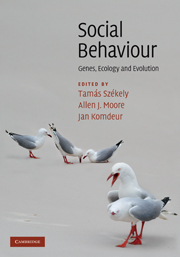Book contents
- Frontmatter
- Contents
- List of contributors
- Introduction: The uphill climb of sociobiology: towards a new synthesis
- Profile: Undiminished passion
- Part I Foundations
- Part II Themes
- 7 Aggression: towards an integration of gene, brain and behaviour
- Profile: From behavioural observations, to genes, to evolution
- 8 Social influences on communication signals: from honesty to exploitation
- Profile: Reputation can make the world go round – or why we are sometimes social
- 9 Important topics in group living
- Profile: A haphazard career
- 10 Sexual behaviour: conflict, cooperation and coevolution
- Profile: In celebration of questions, past, present and future
- 11 Pair bonds and parental behaviour
- Profile: Mating systems and genetic variation
- 12 Adaptations and constraints in the evolution of delayed dispersal: implications for cooperation
- Profile: Selections from a life in social selection
- 13 Social behaviour in microorganisms
- Profile: The de novo evolution of cooperation: an unlikely event
- 14 Social environments, social tactics and their fitness consequences in complex mammalian societies
- Profile: Evolutionary genetics and social behaviour: changed perspectives on sexual coevolution
- 15 Social behaviour in humans
- Profile: Genes and social behaviour: from gene to genome to 1000 genomes
- Part III Implications
- Species index
- Subject index
- References
8 - Social influences on communication signals: from honesty to exploitation
Published online by Cambridge University Press: 05 June 2012
- Frontmatter
- Contents
- List of contributors
- Introduction: The uphill climb of sociobiology: towards a new synthesis
- Profile: Undiminished passion
- Part I Foundations
- Part II Themes
- 7 Aggression: towards an integration of gene, brain and behaviour
- Profile: From behavioural observations, to genes, to evolution
- 8 Social influences on communication signals: from honesty to exploitation
- Profile: Reputation can make the world go round – or why we are sometimes social
- 9 Important topics in group living
- Profile: A haphazard career
- 10 Sexual behaviour: conflict, cooperation and coevolution
- Profile: In celebration of questions, past, present and future
- 11 Pair bonds and parental behaviour
- Profile: Mating systems and genetic variation
- 12 Adaptations and constraints in the evolution of delayed dispersal: implications for cooperation
- Profile: Selections from a life in social selection
- 13 Social behaviour in microorganisms
- Profile: The de novo evolution of cooperation: an unlikely event
- 14 Social environments, social tactics and their fitness consequences in complex mammalian societies
- Profile: Evolutionary genetics and social behaviour: changed perspectives on sexual coevolution
- 15 Social behaviour in humans
- Profile: Genes and social behaviour: from gene to genome to 1000 genomes
- Part III Implications
- Species index
- Subject index
- References
Summary
Overview
Communication is at the core of understanding sociality as an interface between behaviours and phenotypes, and their evolutionary trajectories. Central to communication research is gaining an understanding of the information content of signals and the ecological, social and physiological factors that influence their format. It is clear that individuals which benefit from social exchange can critically influence what information is transmitted, how it is transmitted and whether it is scrambled to prevent eavesdropping. Less clear is how the physical channels through which signals are emitted and received might influence the extent to which they are prone to errors, dishonesty and manipulation. Here we show how sensory systems, perceptual physiology, cognitive decision rules and evolutionary trajectories produce the broad range of signalling modalities and contents that we see in nature. Our overview suggests that experimental evidence on the meaning, honesty and selective benefits of communication for signallers and receivers across invertebrates and vertebrates can provide a taxonomically broad but conceptually similar set of examples. This is not surprising, since studies across diverse lineages have demonstrated that the mechanism and function of communication systems both critically shape social behaviour and are being shaped by sociality. In particular, functional investigations of the sensory systems of vocal communication in songbirds, visual signals in trap-building predators, and chemical signalling in arthropods, have established clear examples of the limits to perception and discrimination of signal design.
- Type
- Chapter
- Information
- Social BehaviourGenes, Ecology and Evolution, pp. 185 - 199Publisher: Cambridge University PressPrint publication year: 2010
References
- 8
- Cited by



